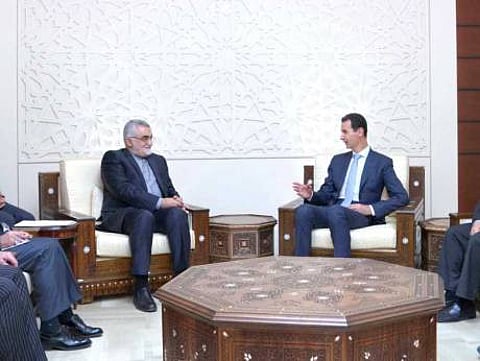UN umbrella a must to enforce peace
On the Syrian conflict, international community has started playing by Putin’s rules, treating Astana, rather than Geneva, as the main reference point

Asked about the last round of Astana talks, Russian Foreign Minister Sergei Lavrov said on October 6, that they had achieved their detailed results vis-a-vis the four de-conflict zones in war-torn Syria. He refused to call them a breakthrough, though, warning against the use of what he described as “lofty words”. Lavrov expected a “productive” new round on October 30-31, toying with the idea of expanding the observatory force that is keeping the ceasefire in Syria, from Russia, Turkey, and Iran to include other countries, without naming any. The top Russian diplomat was effectively setting the tone for the next round of Astana: “Low-key, technical and productive” — but no breakthrough yet.
The Russians are clearly not in a hurry to speed up the process, having successfully drowned the Geneva talks, which were the brainchild of former United States Secretary of State John Kerry. Those talks were held under the auspices of the United Nations and were aimed at drafting a new constitution in Syria and creating a transition government, which would supervise “elections” in Syria, according to UN Security Council Resolution 2254. They tried peddling a Russia-penned constitution in mid-2016, but it was flatly rejected by both the government and opposition delegations. They tried talking to their allies in Damascus about serious political changes, but that too was rejected by both sides, with the opposition refusing to join any formula if it did not specifically demand the departure of Syrian President Bashar Al Assad. Instead of breathing life into the already stagnant political process, Moscow decided to abort it completely, investing in US President Donald Trump’s complete lack of interest in the Syrian political process. This is when the Astana talks popped up earlier in the year, as an informal Russian-created substitute to Geneva; a technical process where no politics were discussed, aimed solely at phased ceasefires throughout Syria.
The drowning of Geneva was mutually agreed upon by Moscow, Tehran, and Ankara — the three guarantors of the Astana process. After seeing the lack of US commitment to Geneva and the low-grade American diplomatic representation at all rounds since January, one-time Geneva enthusiasts like the United Kingdom and France also started to back off quietly, letting Astana happen and doing nothing to revive the Switzerland talks. They too had seemingly lost interest in the Syrian conflict, and surrendered, albeit unwillingly, to Russian President Vladimir Putin’s vision of an endgame — one that ultimately doesn’t lead to regime change in Damascus. Overnight, the international community started playing by Putin’s rules, treating Astana, rather than Geneva, as the main reference point of the Syrian conflict.
For Astana to succeed, it needs a UN umbrella — something that it presently doesn’t have. Without it, no binding and internationally-respected resolution can be implemented to transform the local ceasefires into an effective end to the Syrian war. It also needs guarantees from all guarantors to stop sending arms and troops into Syria. Additionally, Astana cannot last if it is not backed by a credible political process. The four ceasefires of today cannot last forever unless they are accompanied by a local will, from all sides, to end the fighting. It needs to be home-grown, rather than imposed on all sides by the Astana guarantors.
According to the Astana process, tenure of the de-conflict zones is six months only, renewable by mutual consent. But will happen thereafter, with a multitude of foreign troops scattered on all four corners of Syria? Russian troops are here to stay, obviously, for decades to come, and nobody in the international community minds that or seems to object, but what about the Turkish and Iranian forces recently deployed to Idlib in the Syrian northwest? In previous battles, Turkey had relied on Syrian proxies in the battles of Jarablus, Azaz and Al Bab, entrusted with the task of combating Daesh (the self-proclaimed Islamic State of Iraq and the Levant). But now, Turkey is entering Idlib with its official military, estimated to be no less than 500 troops. Similar numbers will march in from Russia and Iran, according to the Astana process, all charged with keeping peace and fighting Hayat Tahrir Al Sham (previously known as Jabhat Al Nusra). Once entrenched in the strategic Syrian city, how and when will these troops leave; on what grounds and at what cost?
For now, the ceasefires include territory north of Homs, east of Damascus, southern Syria, and Idlib. The formula calls for local militias to join forces with government troops in counter-terrorism operations against Daesh — a feat that is technically and politically, very difficult. Damascus cannot send military jets to the de-conflict zones, nor soldiers or tanks, but it is entitled to run them through a “civilian authority”, which is how they were administered before 2011. For the ceasefires to be more effective, they need to include Kurdish territories as well, both east and west of the Euphrates River, and the oil-rich city of Deir Al Zour. Syrians need to be told what will happen within these de-conflict zones — will those who carried arms be pardoned, as some are speculating, and will they be allowed to return to normal life? Will they be confined to their zones or allowed to commute freely around Syria? None of these questions have answers at this stage and nobody in the international community seems to be in a hurry to come up with any.
Sami Moubayed is a Syrian historian and former Carnegie scholar. He is also author of Under the Black Flag: At the frontier of the New Jihad.
Sign up for the Daily Briefing
Get the latest news and updates straight to your inbox


